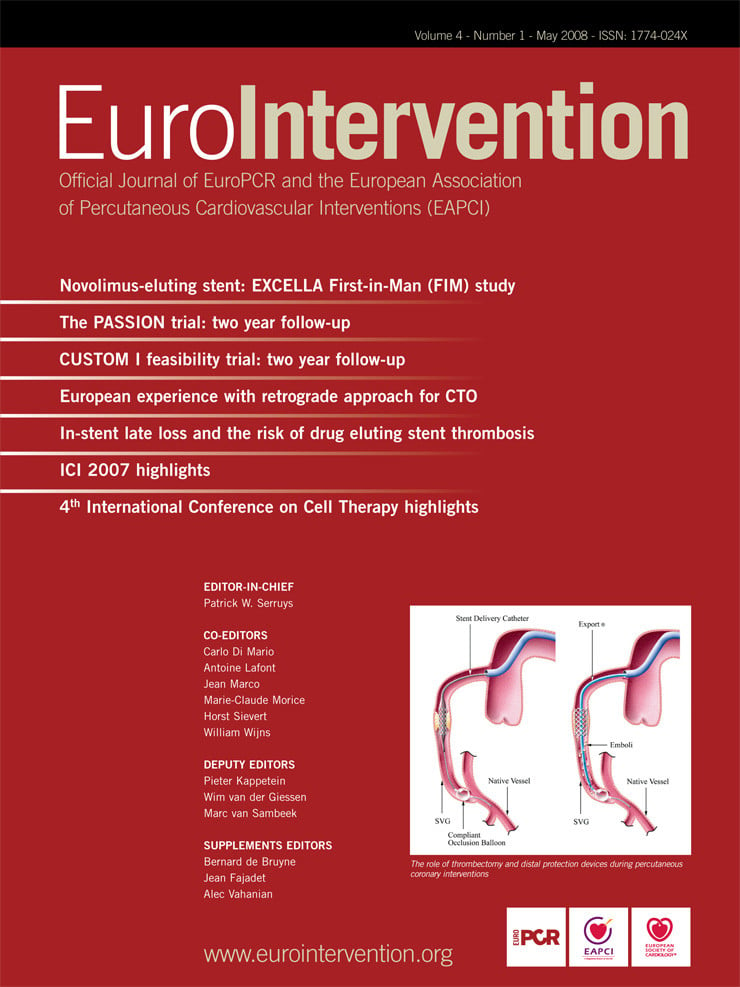While taking part in the 2008 vintage of EuroPCR, the annual meeting of the EAPCI (the European Association for Percutaneous Cardiovascular Interventions), you may wonder why we selected as the dominant theme, the seemingly obvious, yet somewhat dull statement: “Together we achieve more ...”
As a matter of fact, at the present stage of evolution in the field fulfilling such an objective is both critical and not at all trivially within reach.
After decades of explosive technological innovation, we have reached a stage where a given condition can be treated in five different ways, leaving the choice between perhaps ten different options for each strategy. Which of the 20+ CE marked drug-eluting stents shall I recommend for this particular lesion subset? Should this chronically occluded right coronary artery be left as is, or recanalised from the left through the septum after four hours of a glorious battle, or receive a bypass using the ancient surgical approach? And what about the elderly person with critical aortic stenosis, or the renal transplant patient who has carotid disease, or...
Today, patients and physicians are torn between the (too) many options available to them.
As is always the case during periods of rapid progress, there is a palpable tension between conservatism and modernism. Well validated therapies are perceived as old-fashioned by technology aficionados. The results of newer approaches, that are indeed often remarkably innovative, remain uncertain for the long-term for obvious reasons. Opponents and sceptics will argue that their wide application should be constrained until proven equally safe and at least as effective as the previously established standard of care.
Nurturing the tension even further are the unavoidable turf battles between specialists of different disciplines, or sub-specialists within a discipline. These battles are inherent to the process, especially when truly innovative modes of therapy emerge. True innovations are disruptive of existing practices. When it is perceived that significant practice changes could result from the adoption of a newer form of therapy, defensive behaviours arise. This is perhaps understandable, usually not very efficacious, and hardly justifiable since they are the expression of a small, self-interested minority.
By contrast, such attitudes indicate exactly how to resolve the tension and where the solution might come from.
Consensus is the solution, because what is universal among mankind carries the weight of some form of truth.
What our medical community needs to learn and practice, is to exercise consensus-decision making in view of the patient’s best interest. Stakeholders need to be brought together, confronted and decide to collaborate, rather than to compromise. Achieving consensus requires serious treatment of every group’s considered opinion until a convergent decision is developed. Such a process usually benefits from facilitation and requires understanding of the one-dimensional parameter space that is shaping the opinion of the surgeon, the interventional cardiologist or the patient’s family member. Next, consensus failure in one dimension is replaced by a solution in a multi-dimensional parameter space that is both holistic and patient-centred. Accumulation of such consensus-driven decisions creates collective intelligence, defined* as “the capacity of human communities to evolve towards higher order complexity and harmony, through such innovation mechanisms as differentiation and integration, competition and collaboration.” Overcoming individual cognitive bias and collectively cooperating on one process contributes to creating a so-called “noosphere” of public intelligence that distributes for the common good, a global brain, a group mind. “Collective intelligence restores control of the community over society and neutralises the power of vested interests that manipulate information to concentrate wealth.”
Do these seemingly abstract concepts and theoretical approaches to consensus-decision making pertain to EuroPCR 2008?
Yes, very much so.
Is collective intelligence needed in our field?
Yes, more than ever.
Choices of revascularisation need to be weighed against the achievements of medical therapy. Secondary prevention has to be implemented more efficaciously in order to magnify the impact of revascularisation. Dual options for both percutaneous or surgical options have become available in many areas beyond coronary and peripheral atherosclerosis, including structural and valvular heart disease. Obligatory drug-device combinations for the longer term require a more holistic evaluation of patient’s current – and expected – future needs.
Does one need to bring together various stakeholders?
Yes, more than ever.
EuroPCR has always been a global forum, inviting cardiologists, nurses and technicians but also colleagues from the industry and other specialists. EAPCI membership is inviting all those who are primarily interested in Percutaneous Cardiovascular Interventions, without consideration for race, culture, religion or... medical specialty! With more than 100 countries represented, parameters and metrics can only be multiple. A “one size fits all, top down” approach cannot be right.
Now the doors of EuroPCR have opened even wider.
The European Association for Cardiothoracic Surgery (EACTS) and the ESC Working Group for Cardiac Surgery have joined the organising team, such that surgery is now an integral part of the programme. Surgical therapy will be considered along with other options in virtually every session.
Is there any such “noosphere” building up during our meetings?
Yes of course, that is exactly why face-to-face meetings are still popular.
The knowledge base that is available on the internet is largely beyond what any single individual would need to know, or at least have access to. The refresh rate of this knowledge is so much better than was the case in the past, when relying on our favourite textbook. However, sharing skills and grasping consensus-driven decision making are less easily achieved in isolation, while sitting in front of the computer screen.
The programme of EuroPCR Barcelona 2008 offers us many opportunities to acquire this experience, for the best interest of our patients and their families.
* Most of the definitions and considerations regarding “consensus” included in this editorial can be found on ... the internet (see Wikipedia).

